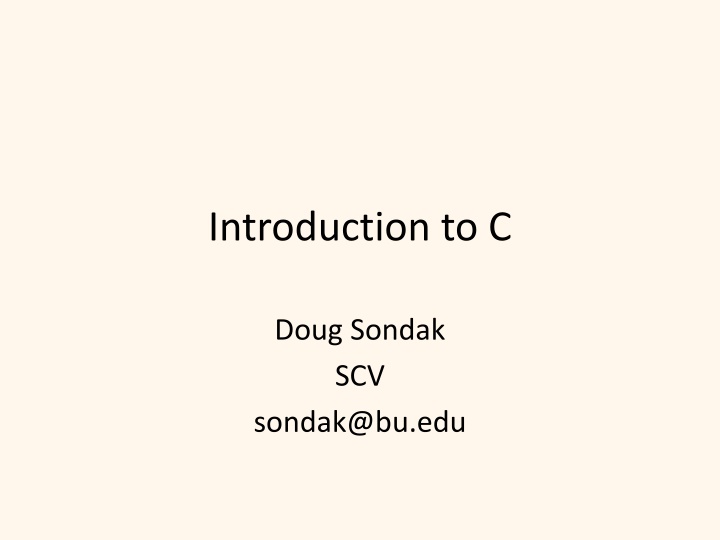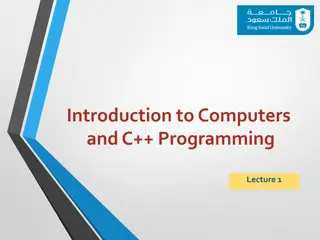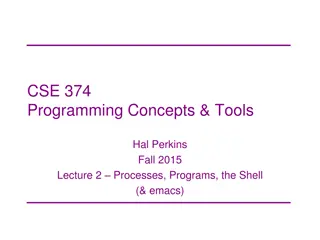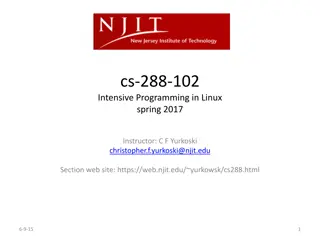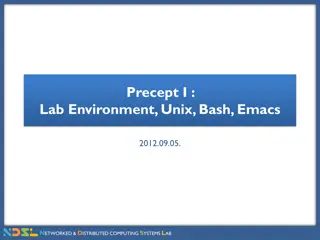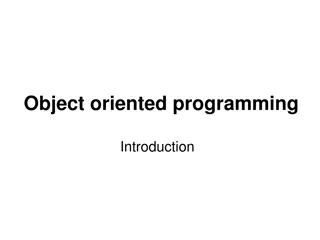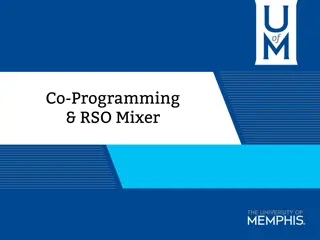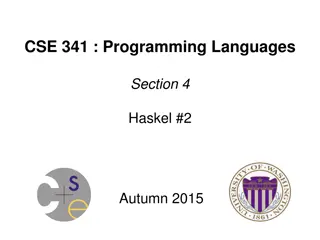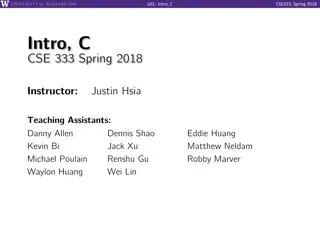Introduction to C Programming with Emacs: Goals and History
Learn about the goals and history of C programming along with practical insights on Emacs editing. Discover why understanding C is essential, how to write simple C programs, manage projects, and why compiled languages are crucial for large-scale computing. Dive into Emacs usage on Unix systems and explore the benefits of this powerful tool.
Download Presentation

Please find below an Image/Link to download the presentation.
The content on the website is provided AS IS for your information and personal use only. It may not be sold, licensed, or shared on other websites without obtaining consent from the author.If you encounter any issues during the download, it is possible that the publisher has removed the file from their server.
You are allowed to download the files provided on this website for personal or commercial use, subject to the condition that they are used lawfully. All files are the property of their respective owners.
The content on the website is provided AS IS for your information and personal use only. It may not be sold, licensed, or shared on other websites without obtaining consent from the author.
E N D
Presentation Transcript
Introduction to C Doug Sondak SCV sondak@bu.edu
Outline Goals Introduction Emacs C History Basic syntax makefiles Additional syntax
Goals To be able to write simple C programs To be able to understand and modify existing C code To be able to manage program projects using an editor and makefile
Introduction Matlab is great! Why do I need to learn a new language?! All codes must be translated to machine language Interpreted language Matlab, Python, Java Translation is performed incrementally at run time Compiled language Fortran, C, C++ Translation is performed once, then executable is run
Introduction (contd) Compiled languages run faster I translated a program from Matlab to C for a user, and it ran 7 times as fast Large-scale computing is usually done with compiled language Some convenient features of interpreted languages result in performance and/or memory penalties
Emacs On Unix systems, one typically uses an editor to write/modify code Emacs and vi are most popular We will talk about emacs If you want to use vi, that s fine
Emacs (contd) Emacs is a wonder tool! We will just scratch the surface Commands can be executed via menus or using the underlying character sequences Although I like the latter, we ll use the menus here Copy the file junk from /scratch/sondak This will be our example file for editing cp /scratch/sondak/junk .
Emacs Exercise Type emacs An emacs window will appear To read an existing file File -> Open File You will be prompted for file name at bottom of window Type junk and hit return
Emacs Exercise (contd) You should now see file contents in window can navigate using arrow keys You can also navigate by clicking on the desired location Click on the 0 in 0.282
Emacs Exercise (3) To delete a character use Delete button Hit Delete 3 times to delete 0.2 Type 1.3 You ve now changed 0.282 to 1.382 Highlight 0.288 with the mouse Don t include spaces before or after Edit -> Cut will delete the highlighted characters Oh no, we made a mistake! Edit -> Undo undoes the previous command. Try it; 0.288 should reappear.
Emacs Exercise (4) The point is the location on the left side of the cursor; i.e., between the character on which the cursor resides and the character to its left. The mark is similar to the point, but it s location is set (i.e., doesn t move with cursor). Suppose we want to delete all the characters between (inclusively) 0.288 and 0.407.
Emacs Exercise (5) Set the cursor on the 0 in 0.288. To set the mark, CTL-spacebar The note Mark set will appear at the bottom of the screen. Move the cursor to the right of 0.407 We place it to the right of the 7 rather than on it because the point is always to the left of the cursor
Emacs Exercise (6) Edit -> Cut will delete all characters between the mark and the point For now, let s put the characters back in by using Edit -> Undo Move the cursor to the start of the current line using CTL-a (CTL-e moves to end of current line) Delete ( kill ) the line with CTL-k Another CTL-k deletes the newline character
Emacs Exercise (7) Meta key is the Esc key We will use M here to indicate the Meta key The Meta key is hit prior to the subsequent key(s), not simultaneously as with CTL Place the cursor at the top of the file M-> will move the cursor to the bottom of the file M-< will move it back to the top
Emacs Exercise (8) Whatever we deleted last is available in a buffer Move the cursor to the beginning of the M1rel line CTL-y yanks the current buffer
Emacs Exercise (9) To save the modified file, File -> Save (current buffer) A note will appear at the bottom of the window saying the file has been saved To save it under a new name, File -> Save Buffer As You ll be prompted for the name at the bottom of the screen Note that when you get these kinds of prompts, you can edit them using emacs commands Type a file name and then move back and forth with CTL-b and CTL-f File -> Exit Emacs to quit Previous version will appear with ~ suffix
Emacs Exercise (10) A built-in tutorial is available Type CTL-h t We won t do anything with the tutorial here, but it s a good resource
C History Developed by Dennis Ritchie at Bell Labs in 1972 Originally designed for system software Impetus was porting of Unix to a DEC PDP-11 PDP-11 had 24kB main memory! 1978 book The C Programming Language by Kernighan & Ritchie served as standard Official ANSI standard published in 1989 Updated in 1999
C Syntax Source lines end with semicolons (as in Matlab) Case-sensitive Spaces don t matter except within literal character strings I use them liberally to make code easy to read Comments are enclosed by /* */ Many compilers also accept // at beginning of comment as in C++
C Syntax (contd) Declarations must declare each variable as being integer, floating-point, character, etc. Required because different types are represented differently internally Since integers have no decimal places, integer arithmetic will truncate result If i=3 and k=2, i/k=1, k/i=0 Program blocks are enclosed within { } Source file suffix is usually .c
C Syntax (3) Simple programs consist of functions and header files Main program is a function called main (surprise!) Functions have return types (int, float, etc.) Main function is defined by the return type, the word main followed by any arguments within parenthesis, followed by the function statements within {} int main(){ function statements }
C Syntax (4) Style note: some people like to arrange the brackets like int main() { function statements } Either way is fine Be consistent!
C Syntax (5) Header files contain re-usable code elements Function definitions, variable declarations, etc. Sometimes use system header files Sometimes you write them yourself Usually have a .h suffix #include <header_file_name.h> Included before function definition Note that the #include statement does not end with a ;
C Syntax (6) A character string is enclosed by double quotes Characters within the quotes will be taken literally This is my character string. Special character \n produces new line (carriage return & line feed) Often used in character strings This is my character string.\n Single character is enclosed in single quotes h
C Syntax (7) Functions are executed by statements that consist of the function name, any required arguments within (), and the ending ; myfunc(arg1, arg2); The function printf can take a character string as an argument and print the string to the screen printf( mystring\n ); Definition of printf is in the include file stdio.h
Exercise 1 Write a hello world program in an editor Program should print a character string General structure of code: include stdio.h define main function call printf function Save it to a file name with a .c suffix (e.g., hello.c) solution
Compilation A compiler is a program that reads source code and converts it to a form usable by the computer Code compiled for a given type of processor will not generally run on other types AMD and Intel are compatible On katana we have Portland Group compilers (pgcc) and GNU compilers (gcc) We ll use gcc, since it s free and ubiquitous
Compilation (contd) Compilers have huge numbers of options See gcc compiler documentation at http://gcc.gnu.org/onlinedocs/ Katana presently has version 4.1.1 For now, we will simply use the o option, which allows you to specify the name of the resulting executable In a Unix window: gcc o hello hello.c
Compilation (3) Compile your code If it simply returns a Unix prompt it worked If you get error messages, read them carefully and see if you can fix the source code and re- compile Once it compiles correctly, type the executable name at the Unix prompt, and it will print your string
Declarations Lists of variables with their associated types Placed in source code at beginning of function Basic types: int Usually 4 bytes float Usually 4 bytes double Usually 8 bytes char Single character One byte
Declarations (contd) Examples: int i, j, k; float xval, time; char name, date; A char variable represents a single character
Arithmetic +, -, *, / No power operator (see next bullet) Math functions in math.h pow(x,y) raises x to the y power sin, acos, tanh, exp, sqrt, etc. add lm flag to compile command to access math library Exponential notation indicated by letter e 4.2e3 Goodpractice to use decimal points with floats, e.g., x = 1.0 rather than x = 1 2 . 4 3 10
Arithmetic (contd) ++ and -- operators these are equivalent: i = i+1; i++; always increment/decrement by 1 Can convert types with cast operator float xval; int i; xval = (float) i;
Printing Values printf will print values as well as character strings Must provide format for each value int num; float x; printf( num = %d x = %f \n , num, x); %d is integer conversion specification (format) %f is float conversion specification Formats correspond to variable list I sometimes line them up for clarity: printf( num = %d x = %f \n , num, x );
Exercise 2 Write program to convert a Celcius temperature to Fahrenheit and print the result. Hard-wire the Celcius value to 100.0 We ll make it an input value in a subsequent exercise Don t forget to declare all variables F = (9/5)C + 32 solution
Pointers Memory is organized in units of words Word size is architecture-dependent Pentium 4 bytes Xeon, Itanium 8 bytes Each word has a numerical address 32 16 8 0
Pointers (contd) When you declare a variable, a location of appropriate size is reserved in memory When you set its value, the value is placed in that memory location 32 float x; 3.2 16 x = 3.2; 8 0 address
Pointers (3) A pointer is a variable containing a memory address Declared using * prefix float *p; Address operator & Address of specified variable float x, *p; p = &x;
Pointers (4) float x, *p; p = &x; 1056 32 p 1052 16 16 1048 8 1040 0 address address
Pointers (5) Depending on context, * can also be the dereferencing operator Value stored in memory location pointed to by specified pointer *p = 3.2; Common newbie error float *p; *p = 3.2; Wrong! p doesn t have value yet float x, *p; p = &x; *p = 3.2; correct
Arrays Can declare arrays using [ ] float x[100]; char a[25]; Array indices start at zero Declaration of x above creates locations for x[0] through x[99] Array name is actually a pointer to the memory location of the first element These are equivalent: x[0] = 4.53; *x = 4.53;
Arrays (contd) If p is a pointer and n is an integer, the syntax p+n means to advance the pointer by n memory locations These are therefore equivalent: x[4] = 4.53; *(x+4) = 4.53;
Arrays (3) Multiple-dimension arrays are declared as follows: int a[10][20]; Values are stored in memory with last index varying most rapidly Opposite of Matlab and Fortran The statements in each box are equivalent: a[0][17] = 1; a[1][0] = 5; *(a+17) = 1; *(a+20) = 5;
Arrays (4) Character strings (char arrays) always end with the character \0 You usually don t have to worry about it as long as you dimension the string 1 larger than the length of the required string char name[5]; name = Fred ; works char name[4]; name = Fred ; doesn t work
sizeof Some C functions require size of something in bytes A useful function sizeof(arg) The argument arg can be a variable, an array name, a type Returns no. bytes in arg float x, y[5]; sizeof(x) ( 4) sizeof(y) (20) sizeof(float) ( 4)
Input from Keyboard fgets reads a character string (character array) char line[100]; fgets(line, sizeof(line), stdin); 2nd argument is no. bytes to read lives in stdio.h sscanf decodes a character string according to specified format int i, j; sscanf(line, %d %d , &i, &j); 2ndargument is character string, so it s in quotes last arguments are addresses lives in stdio.h
Exercise 3 Modify Celcius program to read value from keyboard Declare character array and floats Read character array from keyboard Decode character array into float Calculate temperature Print temperature solution
Dynamic Allocation Suppose you need to allocate an array, but you don t know how big it needs to be until run time? Use malloc function malloc(n) n is no. bytes to be allocated Returns pointer to allocated space lives in stdlib.h
Dynamic Allocation (contd) Declare pointer of required type float *myarray; Suppose we need 101 elements in array malloc requires no. bytes, cast as appropriate pointer myarray = (float *) malloc(101*sizeof(float)); free releases space when it s no longer needed: free(myarray);
For Loop for loop repeats calculation over range of indices for(i=0; i<n; i++){ a[i] = sqrt( b[i]**2 + c[i]**2 ) } for statement has 3 parts: initialization completion condition what to do after each iteration
